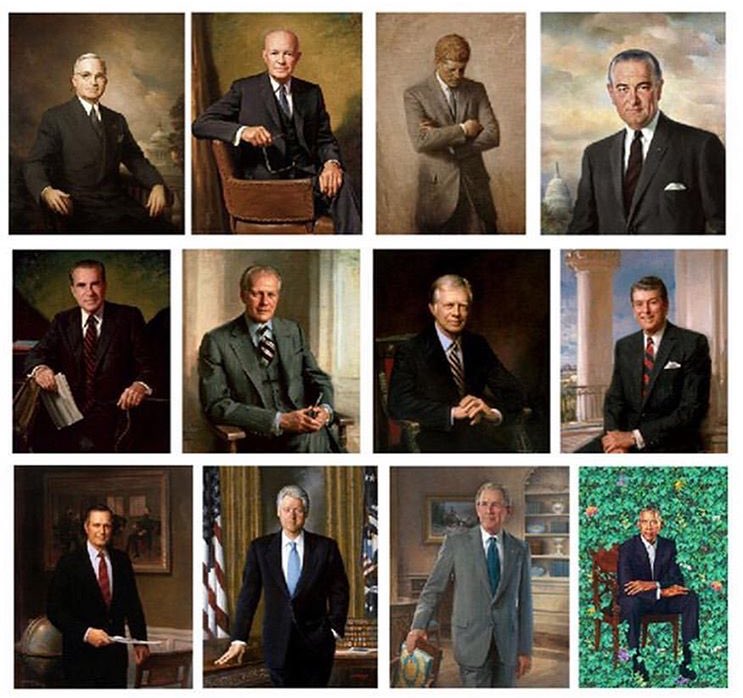
- #Official presidential portraits for free#
- #Official presidential portraits full#
- #Official presidential portraits series#
#Official presidential portraits for free#
During his presidency, he and his administration played a crucial part in curbing the massive federal spending deficits that had soared in the 1980s, even achieving a surplus in revenues for the first time since the 1960s.Ĭlinton established new organizations for free trade, including NAFTA, which eliminated tariffs and trade barriers between Canada, the U.S., and Mexico. The first baby-boomer president, Bill Clinton came to national attention when, at age thirty-two, he emerged as one of the leading reform governors of the Democratic Party. Instead, it is almost as if we are viewing Clinton through textured glass. The background of peacock blue, evergreen, raspberry, and greenish gold becomes a dark blue-gray that complements Clinton’s warm tan complexion.Įven from the far end of the spacious gallery, which is several yards back, the painting does not read as a crisp image. From afar, it coalesces into the president’s sparkling white front teeth, which he reveals through parted, smiling lips.įurthermore, colors that appear bright and bold up close seem more subdued at a distance. For example, there is a pale yellow and baby blue shape resembling a kidney bean about a third of the way up the center of the composition. From our new vantage point, it becomes apparent that the variations in the grid suggest specific facial features. Now that we have examined the technique, let’s move back several feet. In this way, the eyes form the basic unit of composition and scale. Rings of turquoise, green, and aqua surround the black circles of his pupils. Within this warm palette, the blue of the irises of Clinton’s eyes stands out. Along his bulbous nose and underneath his chin, evergreen, eggplant, and burnt sienna represent darker shadows.
#Official presidential portraits full#
The mid-tones of his full cheeks and rounded chin are made up of tangerine, yellow ochre, olive green, eggplant, violet, and even crimson. On the left side of the canvas, where the light hits the president’s face, the diamond tiles are filled with pale aqua, peach, and sage green. At the center of the composition, Close used unexpectedly bright hues to form the oval of Clinton’s face and hair. They resemble nesting blocks of different colors and shapes.
#Official presidential portraits series#
While each diamond is roughly two and a half by two and a half inches, some of them are joined together to form larger rectangles and L-shapes.Ĭlose then filled these geometric fields with a series of loosely painted, multi-colored concentric circles, teardrops, or rectangles. Since diagonal lines form the grid instead of horizontals and verticals, the painting is made up of diamonds instead of squares. He then used the grid as a guideline to enlarge the photograph, transferring and transforming the visual information from each segment to the canvas. Close made a grid on both the original photograph and the canvas. When we are near the portrait, Clinton’s likeness takes a back seat to Close’s technique. Let’s explore the mosaic-like composition. As a result, this portrait of the forty-second president remains a puzzle-like abstraction, even though it alludes to a realistic photograph. Similar to pixels on a screen, the painting is composed of hundreds of color-filled diamonds.
/cdn.vox-cdn.com/uploads/chorus_image/image/58665171/PA_NPG_18_55_Obama_R_copy.1518457375.jpg)
Second, while the work is based on a photograph, it is far more abstract than a typical headshot. This means that his face alone is several feet high, making it about the same size as some of the full-length, life-size portraits in the “America’s Presidents” exhibition.

The first is its size, given that the artist Chuck Close only shows Clinton’s head and shoulders. In this large-scale portrait of Bill Clinton, two things stand out.


Bill Clinton by Chuck Close, 2006, oil on canvas, nine feet tall by seven feet wide.


 0 kommentar(er)
0 kommentar(er)
